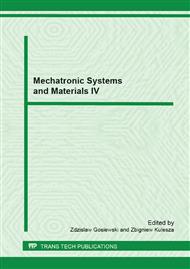p.67
p.73
p.79
p.84
p.90
p.96
p.102
p.108
p.114
HILS for the Design of Three-Wheeled Mobile Platform Motion Surveillance System with a Use of Energy Performance Index
Abstract:
Current tendency in mechatronic design requires the use of comprehensive development of an environment, which gives the possibility to prototype, design, simulate and integrate with dedicated hardware. The paper discusses the Hardware-In-the-Loop Simulations (HILS) mechatronic technique [, used during the design of the surveillance system based on energy performance index [. The presented test configuration (physical controller emulated virtual research object) allows authors to verify responses (in the LabVIEW [) of the mobile platform model, to the optimal control commands (torques), generated by the Real Time controller. Defined energy performance index, supported by the correction velocities, controls the emulated platform while moving along three different trajectories. The demonstrated test results are compared with desired values obtained during numerical computation process of kinematic and dynamic equations of the presented model. The authors investigation of the HILS affected final optimisation of the motion surveillance system design. Real time requirements enforced authors to decrease sampling time of control command (signal generation frequency) and establish high performance execution strategy for on-line algorithm (algorithm execution performed both in Real Time processor and in the FPGA - Field Programmable Gate Array) [. The performed simulations confirmed that the HILS is a powerful technique, which improves system design making that more efficient and low cost consuming.
Info:
Periodical:
Pages:
90-95
Citation:
Online since:
March 2013
Authors:
Price:
Сopyright:
© 2013 Trans Tech Publications Ltd. All Rights Reserved
Share:
Citation:


